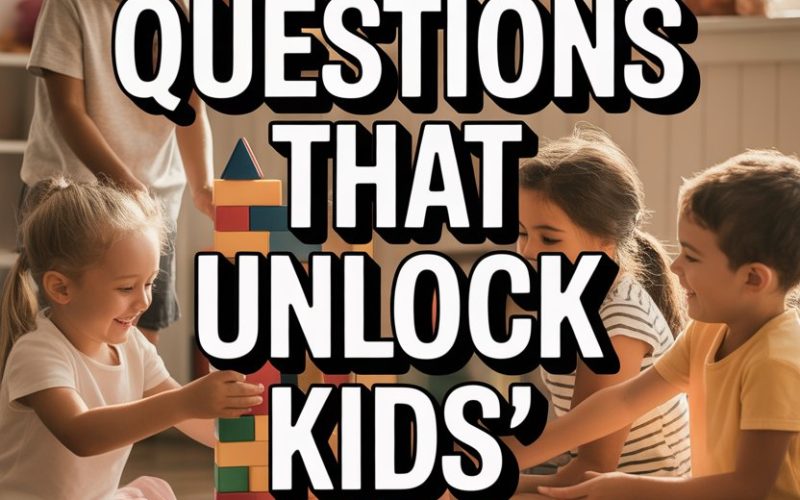Anyone who’s ever tried to get a straight answer from a five-year-old about their day at school knows the struggle. “What did you do today?” “Nothing.” “Did you learn anything?” “Nope.”
But kids are brimming with wild ideas—sometimes they just need the right question to let them tumble out.
Busy parents, rejoice: you don’t need all weekend or a Pinterest-worthy craft kit to spark creativity.
Sometimes, all it takes is asking a question at dinner, in the car, or while wrangling socks.
Below are 15 ready-to-steal questions that can pry open those imaginative minds—and maybe even give you a glimpse into the secret worlds your kids are building when you’re not looking.
1. What would you invent to make life easier or more fun?
Kids have a knack for problem-solving, even if their solutions involve jetpacks for cats or self-tying shoes (Nike, take note). This question steers them toward noticing challenges and dreaming up quirky solutions.
According to Harvard’s Project Zero, invention-based prompts help children develop creative confidence and the ability to think beyond the obvious.
Don’t be surprised if your child’s invention involves unlimited chocolate. That’s called “vision.”
2. If your favourite toy could talk, what would it say?
Suddenly, the teddy bear gains a voice, and so does your child’s imagination. Giving familiar objects personalities encourages empathy and storytelling.
The act of animating the inanimate is a cornerstone of childhood creativity (and, let’s face it, more entertaining than Peppa Pig reruns).
Hint: This one works especially well at bedtime, when soft toys and soft lighting make even the most hardened Lego brick seem poetic.
3. How would the world look if animals could go to school?
Time for a mash-up of biology and pure silly. This question invites kids to bend reality, build new rules, and consider the lives of others—all while giggling about giraffes on jungle gyms.
Researchers have found that fantastical questions like these boost divergent thinking, which is a fancy way of saying “lots of new ideas at once.”
If the idea of a tardy tortoise or a monkey maths teacher doesn’t get your child talking, check their pulse.
4. What new rule would you add to our family?
Give the kids a taste of power—with supervision, of course. Whether they suggest “pancakes for dinner every night” or “everyone must wear socks on their hands,” you’ll get insight into what makes your child tick.
Plus, this question encourages negotiation and cooperative play, both crucial for creative problem-solving.
Extra points if you actually try one of their rules (at least for an evening).
5. If you could paint the sky any colour, what would you choose and why?
Shake up those well-worn neural pathways by asking kids to question the “normal.” There’s a reason Picasso said he spent his life learning to paint like a child: kids see possibilities adults have forgotten.
Research from Child Mind Institute shows that open-ended prompts like this boost creative confidence.
And yes, someone will suggest rainbow polka dots.
6. Who would win in a race: a snail with roller skates or a pigeon on a scooter?
A bit of absurdity goes a long way. This question inspires your child to compare, contrast, and justify choices in a way that feels like play, not homework.
You might even ignite a debate worthy of the dinner table—or a future philosophy class.
Don’t be shocked if your child’s answer includes a backstory about the snail’s secret jet engine.
7. If you had a superpower nobody else has, what would it be, and how would you use it?
Step aside, Spider-Man and Elsa.
This prompt nudges kids to blend wishful thinking with practicality, and it reveals what they value (invisibility to sneak biscuits, perhaps, or the power to freeze vegetables so they never have to eat them again).
Psychologists say role-play and imaginative scenarios help grow emotional intelligence and problem-solving skills.
8. What would you build if you had unlimited Lego bricks?
Open-ended construction questions teach kids to visualise, plan, and innovate—all skills that pay off when GCSEs roll around or the Wi-Fi drops out.
Sometimes, their answer leads straight to the playroom for a marathon building session. Sometimes, it’s architectural theory involving castles, rocket ships, and possibly a dragon hotel.
The classic “what would you make” prompt never gets old.
9. Which animal would make the best Prime Minister and why?
Politics, but make it fun (and safe from actual politicians). Children are natural satirists with a keen sense of what matters: loyalty, honesty, snack policies.
This question stretches their ability to argue a point, defend their reasoning, and imagine new leadership styles. One study from University of Cambridge shows that children who practice giving reasons learn to think more deeply.
You’ll want to write down their answers for future campaign slogans.
10. If you could create a brand-new holiday, what would we celebrate?
Time to shake up the calendar. This question lets your child invent traditions, rituals, and excuses to eat more cake.
Will they pick “National Pajama Day,” “Unicorn Appreciation Week,” or “Chocolate for Lunch Day”?
The answer offers a window into what makes them feel special—and what they think the world needs more of.
Warning: You could end up making a glitter mess. Or eating chocolate for lunch. Both outcomes have their perks.
11. What would you find at the end of a rainbow—besides a pot of gold?
Classic stories are just a starting point. This prompt encourages your child to riff on familiar fairy tales and stretch beyond the expected. You’ll hear everything from talking mushrooms to intergalactic cupcakes.
Storytelling, especially when kids rewrite old tales, supports language development and creative thinking—according to literacy experts.
And it’s much more interesting than, “What did you do at school today?”
12. If you could swap places with any character from a book or film, who would it be?
Stepping into another’s shoes is a recipe for empathy and new ideas. When children imagine themselves facing new challenges or wielding a magic wand, they’re not just practising escapism—they’re building emotional and creative intelligence.
According to child development research, role-play is a proven way to grow flexible thinking.
Next time your child wishes they were a wizard, or a dinosaur with impeccable table manners, you’ve got a conversation starter ready.
13. What would you put in a museum all about you?
Kids love being the centre of attention (who doesn’t?). Asking them to curate their own “exhibits”—from finger paintings to chewed-up pencils—encourages reflection and self-expression.
This kind of question helps children link their experiences to creative output, a key skill that artists and scientists alike share.
Bonus: You might actually discover the location of the missing socks.
14. If you could combine two animals to make a brand new species, what would it be called?
Mad science and vocabulary, all in one. When your child invents a “tiger-bunny” or an “elephant-lizard,” they’re experimenting with classification, language, and pure invention.
This mash-up approach encourages flexible thinking and creativity, which researchers say are vital for adapting to new situations.
It also guarantees at least one new imaginary pet you’ll be hearing about for a while.
15. If you could invent a new flavour of ice cream, what would it taste like?
Food, glorious food—the perfect prompt for a child, or anyone post-3pm. Creating a new flavour (and maybe drawing or describing it) allows kids to combine sensory imagination with real-world references.
According to developmental psychologists, linking ideas from different senses and domains is a hallmark of creative thinkers.
Just brace yourself for “spaghetti-mint” or “broccoli-chocolate swirl.” At least you don’t have to actually eat it.
Bringing Out Their Inner Genius (Even on a School Night)
Cultivating creativity in kids isn’t about having the fanciest supplies or planning Instagram-worthy activities. Most often, the true sparks fly during a car ride home, while stirring the pasta, or at tuck-in time.
It’s about being curious together, laughing at the wild and the weird, and showing your kids their ideas matter—even if those ideas involve unicorns as Prime Minister or a museum dedicated to lost shoes.
Steal these questions, tweak them, or use them as inspiration for your own.
Children who feel heard, valued, and encouraged to imagine are the ones most likely to surprise you—not just with their creativity, but with their sense of joy.
And if tonight’s dinner conversation features a snail on roller skates, you’ll know you’re on the right track.





